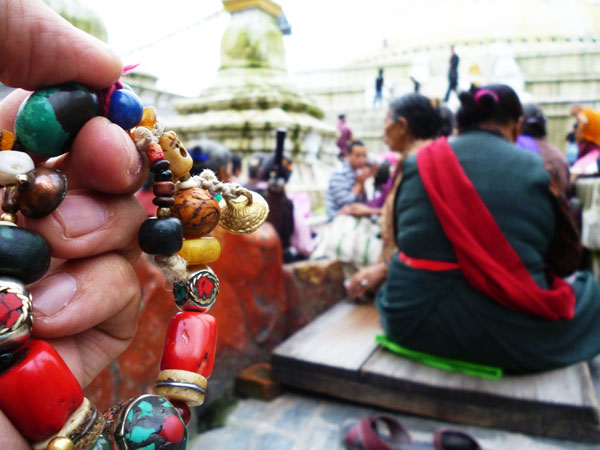 For millennia , the rural cultures of Tibet, Nepal , Bhutan and Mongolia, have worn the bracelets Theng ngnà , these amulets have for each element a correct interpretation of mystical meanings . They are symbols of respect and veneration, which are used by the monks, shamans, animists rural people and nomadic tribes in remote regions of the Himalayas. According to careful scholars of ancient Tibetan iconography as Nebesky – Wojkowitz, writers on the origin of the ancestral deities, knowledge of these amulets are transmitted orally in the Nordic region of Amdo, in Thang-Lha (Byang Thang) at the foot of the Sacred Mountain Yar – Lha – Sham – Po, there is little information available outside of this context, there are not names and dates specified in Tibetan mythology. Many details have disappeared over time, this makes us see how the popular landmark is the only witness, the rites and traditions concerning the gods of the four mountains. It is said that God Yar – Lha – Sham – Po (pre-Buddhist deities for the nomadic tribes of the Yar and the rest of the Tibetan population), had given a wise healer Bon-po, the task of creating a powerful talisman that contained elements of light, sacred stones of the mountain, three metals, “Dzi” the jewel fell from the sky, plants with many beneficial properties, and containing the three main colors merged into white light. The amulet was to be able to give from the heart of the people, the celestial energy and spiritual virtues. Blue Lapis= Will, Yellow Amber= Wisdom, Red coral=Action. For the Himalayan population the metals and stones have different characteristics with regard to the irradiation of energy. According to the myth, the God Yar-Lha-Sham Po, has extraordinary magical powers, rides a white yak. From the mouth and nostrils of the mighty animal out lightning and thunder that give rise to snow avalanches. This deity of the mountain can destroy the big rocks of the cliffs, it turns into a white man who arouse sensual passion of women and girls of the villages and regions. In the Tibetan historiology God Yar-Lha-Sham Po is called the noble gods, and represents the power of the royal family. Before Buddhism, members of the nobility worshiped the deities of Bon; these families ancestors were using stones, symbols and amulets protectors Theng Ngnà. For a long time they remained faithful to these particular amulets that also possessed a secret ingredient. In Tibetan mythology the divine images of amulets are identified with religious elements, rather than on the same mountain (considered deities). The gods of the Tibetan pantheon are imbued with the energy of the animist and Buddhist mysticism, represented in rocks, animals, ancestors, paintings, symbols and amulets.
For millennia , the rural cultures of Tibet, Nepal , Bhutan and Mongolia, have worn the bracelets Theng ngnà , these amulets have for each element a correct interpretation of mystical meanings . They are symbols of respect and veneration, which are used by the monks, shamans, animists rural people and nomadic tribes in remote regions of the Himalayas. According to careful scholars of ancient Tibetan iconography as Nebesky – Wojkowitz, writers on the origin of the ancestral deities, knowledge of these amulets are transmitted orally in the Nordic region of Amdo, in Thang-Lha (Byang Thang) at the foot of the Sacred Mountain Yar – Lha – Sham – Po, there is little information available outside of this context, there are not names and dates specified in Tibetan mythology. Many details have disappeared over time, this makes us see how the popular landmark is the only witness, the rites and traditions concerning the gods of the four mountains. It is said that God Yar – Lha – Sham – Po (pre-Buddhist deities for the nomadic tribes of the Yar and the rest of the Tibetan population), had given a wise healer Bon-po, the task of creating a powerful talisman that contained elements of light, sacred stones of the mountain, three metals, “Dzi” the jewel fell from the sky, plants with many beneficial properties, and containing the three main colors merged into white light. The amulet was to be able to give from the heart of the people, the celestial energy and spiritual virtues. Blue Lapis= Will, Yellow Amber= Wisdom, Red coral=Action. For the Himalayan population the metals and stones have different characteristics with regard to the irradiation of energy. According to the myth, the God Yar-Lha-Sham Po, has extraordinary magical powers, rides a white yak. From the mouth and nostrils of the mighty animal out lightning and thunder that give rise to snow avalanches. This deity of the mountain can destroy the big rocks of the cliffs, it turns into a white man who arouse sensual passion of women and girls of the villages and regions. In the Tibetan historiology God Yar-Lha-Sham Po is called the noble gods, and represents the power of the royal family. Before Buddhism, members of the nobility worshiped the deities of Bon; these families ancestors were using stones, symbols and amulets protectors Theng Ngnà. For a long time they remained faithful to these particular amulets that also possessed a secret ingredient. In Tibetan mythology the divine images of amulets are identified with religious elements, rather than on the same mountain (considered deities). The gods of the Tibetan pantheon are imbued with the energy of the animist and Buddhist mysticism, represented in rocks, animals, ancestors, paintings, symbols and amulets.
 Consecration of the amulet
Consecration of the amulet



